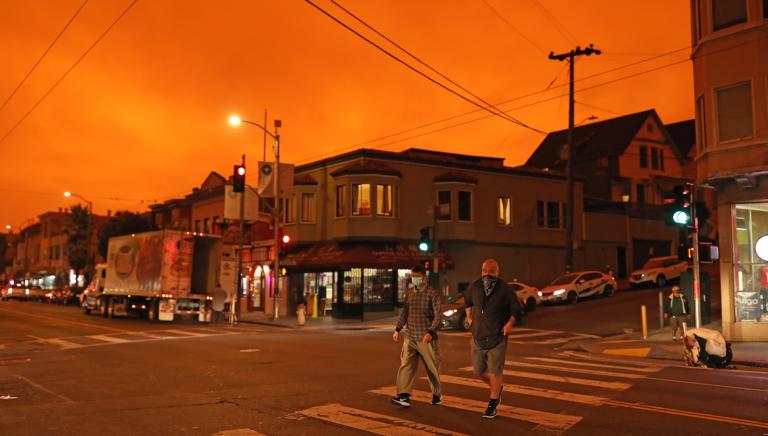Mr. Tucker,
Your story about transitioning from climate skepticism to climate realism has gotten quite a bit of attention and interest among folks on “my side” of that debate, as you can imagine. I had wondered if it were still possible for people to be “defeated by facts” and change their minds about issues tangled in America’s contentious partisan warfare. I don’t know your whole story, but if that’s what you’ve done, you’re to be commended. Intellectual self-discipline and courage are rare in U.S. politics these days.
I write not only to thank you, but to encourage you to keep going. Keep pursuing this line of inquiry. Keep thinking about changes in the climate and what they mean for America and the world. Recognizing the problem is the first step in a long journey, and no one, not even the most devoted climate advocate, is certain where that journey ultimately leads.
As you dig, you’ll discover that there’s some disagreement over just how much climate change is “too much” — how much humans ought to tolerate/adapt to vs. how much they should try to prevent. That issue has not been and can not be settled with any certainty. Ultimately it’s a question of values, and different people will value risk, economic growth, and social justice differently.
Nonetheless, climate scientists have done their best to identify the level of CO2 in the atmosphere that would risk pushing the climatic system over dangerous, irreversible thresholds. Over time, their consensus has changed, but it’s always been to revise the level downward. First it was 550 parts per million of CO2 in the atmosphere. Then it was 450, which remains the general U.N. target and what’s reflected in the 2007 IPCC report. Now many people are arguing that the report is conservative and out-of-date and the latest science suggests 350 ppm. (Currently, we’re at 392 ppm.)
Debating the difference between 450 and 350 is a bit like an asthmatic, overweight couch potato debating whether to run the marathon or do the Ironman triathlon. We haven’t even started stretching, much less jogging. We’re already headed into a world of high uncertainty and great danger, and we are completely unprepared for it.
Reaching either target, 450 or 350, would require enormous changes in the global industrial base. Imagine the extraordinary mobilization of U.S. industrial resources in the run-up to WWII. Now imagine that level of mobilization, coordinated across all the world’s countries, sustained for a century. That’s the scale of the challenge.
Climate change is not a pollution problem like smog was a pollution problem. There is low-sulfur coal, but there is no low-carbon coal — fossil fuels just are carbon. It’s not a waste product; it is the product. Burning fossil fuels intrinsically produces CO2, and the only way we know to filter out and dispose of CO2 — carbon capture and sequestration (CCS) — is wildly expensive and largely untested at scale. But the only alternative to CCS is to burn less fossil fuels.
That, then, is the challenge for the U.S.: reducing fossil-fuel combustion enough to bring down greenhouse gas emissions to close to zero by 2050. What would it take? For one thing, the energy industry would have to transform at every level; trillions of dollars of new investment would be needed in carbon-free power generation, storage, and transmission. Land-use planning would have to transform to encourage more dense, walkable development served by public transit. Agriculture would have to transform to reduce soil degradation and methane emissions. Shipping and freight; plastics; construction — no sector of the economy would escape the need for substantial, rapid changes.
So: If we take the danger seriously, we take seriously the need for some fairly gigantic changes on a relatively short timescale. How can those change be brought about?
Mr. Tucker, you ask: “Is it even possible to be a libertarian and an environmentalist — or a conservative and an environmentalist, for that matter?”
These are good questions! At least when it comes to climate change, I don’t think anyone has explored them with the care and attention they deserve. The question you have to answer is: How much of the enormous changes necessary can be driven by policy premised on small government, low taxes, and reduced regulation?
Lots of my leftie friends would respond: none! But I think that’s wrong. I think there are actually huge areas of public policy ripe for green/libertarian cooperation. I once wrote that …
… greens and conservatives ought to be able to agree on rationalizing existing regulations. Some regulatory incentives degrade environmental and economic performance. You could point to fossil-fuel subsidies, antediluvian utility regulations, unpriced carbon emissions, any number of tax breaks and incentives that favor industry incumbents, even parts of the Clean Air Act. These are market distortions that incentivize inefficiency (i.e., stupidity) and therefore waste (i.e., pollution). Removing or rationalizing them — making a more perfect market, with more competition, better information, and lower barriers to entry — would improve environmental performance.
I still believe that: a freer, more transparent market, with all costs and benefits internalized into prices, would be a cleaner market. There’s no reason greens and libertarians can’t find common cause on that score.
Greens want communities that generate more of their own energy and food, that are more self-reliant and resilient, less dependent on large, distant power centers. Is rugged self-reliance not a conservative virtue? Right now the energy industry is the sector of our economy that most resembles socialism: rule by a cozy cabal of politicians, cartels, and corporate welfare recipients. Greens want to break that cabal up, to decentralize control over energy, to expose it to more competition and innovation. Is decentralized power not a conservative virtue?
In short, there’s a great deal that libertarians, conservatives, and climate hawks can agree on in the short-term. I hope you will set yourself to the task of creating some of those coalitions.
In the end, though, I don’t see how changes of the scale necessary can be pulled off without strong, consistent government rules and without considerable government spending. Ultimately, I don’t see how “small government” can tackle pressing global problems.
But I’m a liberal! You’d expect me to say that. Maybe you’ll see it differently. I hope you’ll keep thinking, keep digging, and keep writing about it. This debate badly needs a productive, reality-based conservative voice.
Best,
DR




